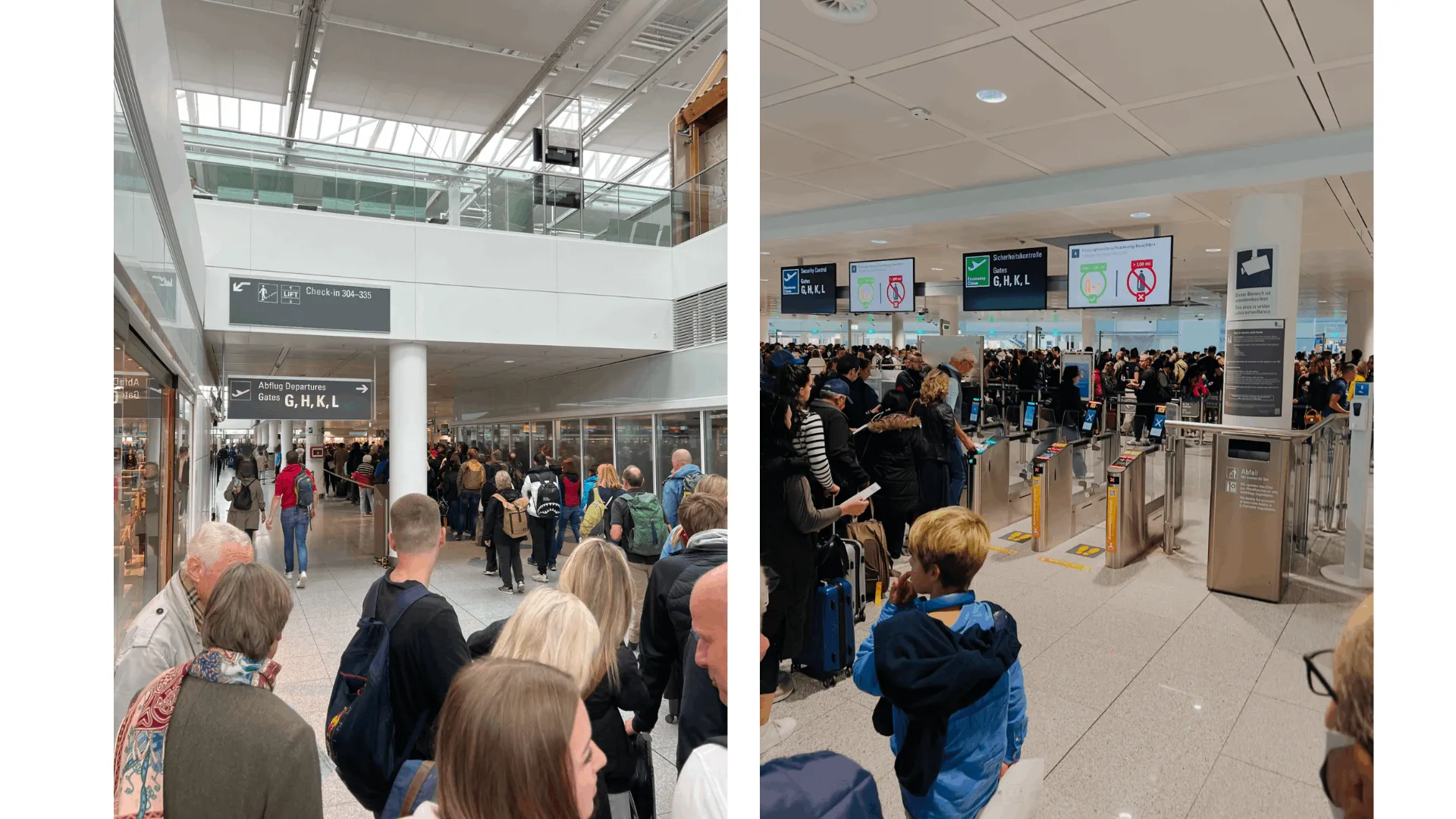What Airports Can Learn from MQTT
I showed up at a major airport in Germany 2.5 hours ahead of my scheduled departure. This was much earlier than my past departures from the airport, and at no point did I think I’d be at risk of missing my flight.
I had checked in a day prior, carried only a small carry-on, and had just stepped off a smooth train ride (thank you, Deutsche Bahn) from Landshut Hbf to the airport. Everything seemed set for an easy departure.
As I approached the terminal building, I noticed a long queue forming. I briefly wondered why but didn’t think much of it. Upon reaching security, I was directed to a line that wasn’t heading toward the security gates but rather snaking off somewhere else. Complying, I joined the line with my small bag, assuming it was just a busy Saturday morning.
Funny enough, the line started inside the terminal but then wound outside, wrapped around the building, and just kept going. It was the same queue I had noticed 20 minutes earlier, and it showed no sign of moving quickly.
Here’s a video that still doesn’t quite capture how absurdly long the line was.

The Chaos Begins
And so, the waiting started. Anxious travelers, uncertain timelines, and a collective worry about missing flights. It was cold, and among us were seniors, children, and individuals with limited mobility—yet we were all stuck in the same endless queue that just kept growing.
Moments of false hope arose whenever the line seemed to move, only for us to realize that it was just an airport staffer redirecting us into yet another hairpin turn behind some trees. There was no way to gauge actual progress.
Desperation set in. Some people, nearly in tears, began cutting in line, while the rest of us crawled along at an excruciating pace. Almost two hours later—after looping through multiple floors inside the terminal—I finally reached security.
Business Class? Not Really.
At this point, I wasn’t flying business class but was somehow ushered into that lane. I thought, “Great! This will move faster.” But no.
The usual economy line had multiple stations for putting bags through, allowing several people to pass through simultaneously. In contrast, the “exclusive” business lane only had two security machines operating in a serial fashion—one after another—which significantly slowed things down.
Meanwhile, my Air Canada app displayed a cruel update: my flight had already taken off… or so I thought. Still determined, I pushed through security and sprinted to my gate.
Fortunately, the pilots had delayed the departure because half the plane—mostly non-connecting passengers—were still stuck at security. I made it. But as I sat down, I couldn’t help but reflect on how one of the world’s most efficient airports had been brought to its knees that morning.
It wasn’t just another Saturday. It was a long weekend, and the day after Oktoberfest ended. (I’m not big into drinking, as you might guess.)
What Could Have Been Done Better?
Looking back, a few obvious things could have helped ease the chaos for both passengers and airport staff:
Proactive Airport Alerts: The airport should have analyzed past trends and notified airlines about the increased departure time requirements.
Better Airline Communication: Airlines regularly send gate change and weather alerts. They should also be able to notify passengers about extreme security delays.
Real-Time Queue Management: Airport staff should have walked through the lines, checking boarding passes and prioritizing passengers who needed to get through security within the next hour.
Early Warnings at Entry Points: Passengers arriving at taxi drop-offs or train stations should have been informed about the long lines so they could queue up immediately instead of wasting time inside the terminal.
Support for Vulnerable Travelers: Those assisting elderly passengers or individuals needing special support should have been given an alternate, faster-moving option.
Self-Service Check-In Devices: Airline staff should have had mobile tablets to assist passengers with printing boarding passes while waiting in line.
Better Announcements: Automated announcements repeating "things are slow today" were unhelpful. Instead, they should have provided estimated wait times and ongoing measures being taken to address the situation.
Smarter Security Routing: Travelers should also keep an eye on the layout. If a security line has multiple lanes handling trays at once, head there instead of blindly following a queue moving at a snail’s pace.
Where MQTT Fits Into This Mess
If you haven't yet connected the dots to MQTT tech, let me do it for you:
Prioritizing passengers based on urgency (e.g., departure time, carry-on only travelers) → Assigning QoS levels to different traffic streams)
Regular updates to passengers → MQTT retained messages or last will and testament (LWT) for consistent awareness
Staff validating passengers for faster processing → Schema/data validation in HiveMQ Data Hub
Security lanes that handle multiple passengers at once → MQTT shared subscriptions for load balancing
Passengers missing flights because they weren't notified in time → Why clean session defaults in MQTT can be risky
Ultimately, the airport that morning lacked an intelligent system to dynamically adjust for demand and communicate effectively. Just like in data management, inefficiencies stack up when real-time coordination and prioritization are missing.
And just like my nearly missed flight, your system’s data pipeline is only as strong as its weakest link.
Your Takeaway
Whether you’re designing airport operations or an MQTT-based data pipeline, make sure:
You anticipate peak loads and adjust resources accordingly.
You have proactive notifications to users (or clients) about potential delays.
You implement priority handling for urgent cases.
You don’t introduce bottlenecks where none are needed.
Otherwise, you’ll find yourself running to the gate, hoping the pilots are generous enough to wait.

Gaurav Suman
Gaurav Suman, Director of Product Marketing at HiveMQ, is an electronics and communications engineer with a background in Solutions Architecture and Product Management. He has helped customers adopt enterprise middleware, storage, blockchain, and business collaboration solutions. Passionate about technology’s customer impact he has been at HiveMQ since 2021 and is based in Ottawa, Canada.
